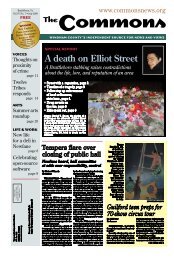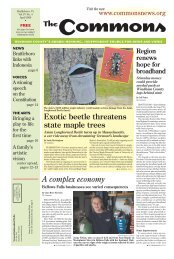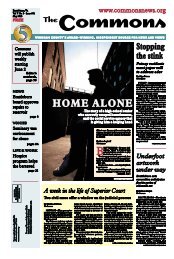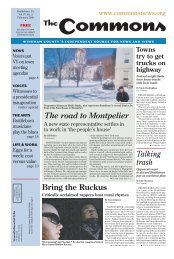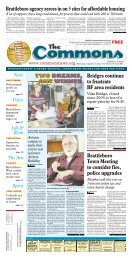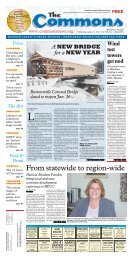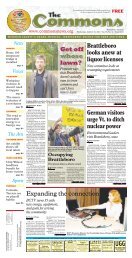voices - The Commons
voices - The Commons
voices - The Commons
Create successful ePaper yourself
Turn your PDF publications into a flip-book with our unique Google optimized e-Paper software.
22 <strong>The</strong> <strong>Commons</strong> • October 2008 <strong>The</strong> <strong>Commons</strong> • October 2008 23<br />
<strong>The</strong> Arts<br />
FRoM<br />
gut<br />
tHE<br />
Founding members<br />
of GUtWorks, Daniel<br />
Burmester, Jonathan Maloney,<br />
and Kali Quinn (inset).<br />
theater company incorporates multimedia<br />
in mission to tell ‘visceral stories’<br />
By caitlin Baucom<br />
<strong>The</strong> <strong>Commons</strong><br />
aTHeNs—<strong>The</strong>atergoers<br />
around Brattleboro were recently<br />
treated to the inaugural<br />
performances of This Is the Place<br />
of Parting, a new multimedia collaboration<br />
by playwright Neil<br />
Knox and gUTWorks, a young<br />
theater company dedicated to<br />
telling “visceral stories.”<br />
Featuring puppets, film, a live<br />
score, physics, and hand-held<br />
lighting, the piece provided a<br />
cinematic spectacle that one audience<br />
member described as<br />
a “choose-your-own adventure.”<br />
Founded in New York, gUT-<br />
Works, now based in athens,<br />
recently transitioned to working<br />
mainly in southern Vermont,<br />
putting down new roots in the<br />
thriving theatrical and artistic environment<br />
of Windham County.<br />
Committed to performing new<br />
and innovative work, gUTWorks<br />
has already established ties<br />
within the community and hopes<br />
to build a working relationship<br />
with local audiences.<br />
<strong>The</strong> three founding members<br />
of gUTWorks met at the<br />
Dell’arte International school<br />
of physical <strong>The</strong>ater in Northern<br />
California. Kali Quinn was there<br />
working toward her MFa, when<br />
Daniel Burmester and Jonathan<br />
Maloney came out to attend a<br />
workshop. <strong>The</strong>y wound up moving<br />
to Manhattan at the same<br />
time, and in between working on<br />
various other shows began their<br />
first project together.<br />
gUTWorks describes “Vamping,”<br />
an original one-woman show<br />
performed by Quinn, directed by<br />
Maloney, and assisted by Burmester,<br />
as “a dynamic multimedia<br />
theater piece that explores the<br />
struggles of senile dementia. It<br />
is seen through the eyes of Julia,<br />
an elderly woman confined<br />
to a nursing home in her later<br />
years, and the world that surrounds<br />
her, both in reality and<br />
her fading mind.”<br />
<strong>The</strong> show had an extensive run<br />
at a variety of venues, including<br />
its premiere Off-Off Broadway at<br />
HeRe art Center’s 2006 american<br />
Living Room Festival. It has<br />
also played in terraNOVa’s soloNOVa<br />
Festival at ps122, at<br />
the Dialogue ONe festival at<br />
Williams College, and Luminz<br />
performing arts studio in Brattleboro.<br />
excerpts from the show<br />
have been featured at various locations<br />
around Manhattan and<br />
Vermont.<br />
critical acclaim<br />
Quinn was hailed as “a talented,<br />
immensely watchable,<br />
and vibrant performer” by Nigel<br />
Maister, artistic director of<br />
the Todd International <strong>The</strong>atre<br />
program at the University of<br />
Rochester.<br />
“Vamping is a deeply personal<br />
and impressively honest piece of<br />
theatre that effectively captures,<br />
with theatrical grace and wit, the<br />
universality of love and loss,”<br />
Maister wrote.<br />
<strong>The</strong> show’s multimedia aspects<br />
functioned differently from those<br />
in “parting.” says Maloney: “We<br />
had screens, but they acted more<br />
as a setting. <strong>The</strong> show was about<br />
dementia and alzheimer’s, and<br />
the [multimedia] acted as a ‘lifeline’<br />
to the audience, a way of<br />
getting inside her mind.”<br />
<strong>The</strong> set consisted of the screen,<br />
an afghan, and a wheelchair,<br />
which “shifted… it was only a<br />
wheelchair for maybe five minutes,<br />
then it took on the roles of<br />
other props, objects throughout<br />
[the rest of the show].”<br />
This initial collaboration was<br />
so successful that the three<br />
decided to continue the partnership.<br />
“We thought, why just keep<br />
auditioning and trying things on<br />
our own?” Kali says. “Of course,<br />
we still do that, but we worked<br />
together so well that we wanted<br />
to keep doing it.”<br />
<strong>The</strong> three come from diverse<br />
backgrounds and disciplines,<br />
including film and media, ensemble<br />
and physical theater, and<br />
clowning. This diversity serves<br />
gUTWorks’ mission to “serve<br />
theatrical story telling from a<br />
multi-faceted approach in order<br />
to reach a diverse audience.”<br />
<strong>The</strong>ir next show was the american<br />
premiere of “No Man’s<br />
Island,” a new play by celebrated<br />
australian playwright<br />
Ross Mueller.<br />
Quinn directed Burmester and<br />
Maloney in the two-man production,<br />
which “plies the emotive<br />
depths of two haplessly damaged<br />
souls,” the company’s Web<br />
site says.<br />
“With the two locked in the<br />
isolation of a cell together and<br />
their crimes and sentences unknown,<br />
we plunge to the core of<br />
their confusion, need, and boiling<br />
loneliness. Tim and Robbie<br />
may have come to prison from<br />
desperate parts of the outback,<br />
at different times and for separate<br />
felonies, but now their lives<br />
are indefinitely converging into<br />
one as they become striking reflections<br />
of each other.”<br />
This show is the only one<br />
they’ve done that existed in a<br />
finished form when they took it<br />
on, and was more traditional in<br />
setting, with no media and a full<br />
set. Josh sherman of nytheatre.<br />
com said, “Quinn, Burmester,<br />
and Maloney have brought to<br />
life a powerful new piece that deserves<br />
a longer run and as much<br />
attention as it can grab.”<br />
coming to Vermont<br />
soon after, Maloney and Quinn<br />
came to Vermont to teach at the<br />
putney school’s summer program.<br />
Impressed with the area<br />
and its artistic possibilities, they<br />
decided to stay, and Burmester<br />
soon followed.<br />
“It’s so much easier here,” says<br />
Quinn. “We’ve found jobs that fit<br />
in with what we’re doing… it’s so<br />
welcoming. space exists, people<br />
want to help.”<br />
<strong>The</strong>y like the idea of a returning<br />
audience, a core group of<br />
people who are interested in<br />
what they do and will come again<br />
and again. “In a smaller community,<br />
we can really show our<br />
diversity over time,” says Maloney.<br />
“It’s exciting that the same<br />
people will continue to come,<br />
they’re supportive and interested.<br />
In New York, you are what<br />
you are and people come or they<br />
don’t… there’s no community<br />
that returns, is invested.”<br />
This is particularly helpful<br />
given their practice of holding<br />
“talk-backs” after the shows. <strong>The</strong><br />
sessions afford audiences the opportunity<br />
to offer criticism, ideas,<br />
or thoughts on the piece they’ve<br />
just witnessed.<br />
“Our projects are completed<br />
when we show them, but then<br />
again we’re always looking to<br />
shift, to improve it,” says Maloney.<br />
“<strong>The</strong>ater and film usually<br />
can’t show process, so talk-backs<br />
really let the process come out<br />
for the audience to see.”<br />
“It is hard,” says Quinn. “Having<br />
to talk about something<br />
you’ve just seen can be difficult.<br />
Often people want to ask<br />
questions instead of offering constructive<br />
criticism, or it’s hard<br />
for them to speak up at all. But<br />
when we did ‘parting’ in Bellows<br />
Falls, over 50 people stayed and<br />
they really were frank… they had<br />
no problem telling us what they<br />
thought.”<br />
“This Is the place of parting”<br />
is the first work they conceived<br />
since the three came to Vermont.<br />
It started with a script by Neil<br />
Knox, who met Quinn while in<br />
graduate school at sarah Lawrence,<br />
where she was a teaching<br />
assistant. after Knox graduated,<br />
he looked for a company<br />
to produce his work and noticed<br />
that Quinn had co-founded<br />
gUTWorks.<br />
“He sent the play, and it was so<br />
cinematic and seemingly impossible,”<br />
Quinn says. “That made us<br />
really want to do it.”<br />
<strong>The</strong>y began collaborating<br />
remotely with Knox, sending<br />
ideas back and forth. “He would<br />
send us a bunch of ideas, we’d<br />
say ‘Well, we like this and this,<br />
maybe we could change this and<br />
then do something else here,’<br />
and he’d respond again. He’d<br />
send us these huge long descriptions,”<br />
Quinn says. “<strong>The</strong> piece<br />
was quite modular, and then we<br />
extracted what became the final<br />
performance.”<br />
This was the first show they’d<br />
worked on which involved a<br />
number of other people. “It was<br />
a relief to have all of those extra<br />
minds,” says Quinn. “This is<br />
something we could never have<br />
done in New York… to bring in<br />
three other actors and two designers<br />
and house them. It was<br />
great. <strong>The</strong>y were all people we<br />
knew individually, and just knew<br />
they would be great together.<br />
We’ll definitely work with them<br />
again in the future.”<br />
<strong>The</strong>y plan to take “parting”<br />
on tour, after further revisions,<br />
taking into account feedback received<br />
at the talk-backs.<br />
<strong>The</strong> trio is now in residence<br />
at Vermont academy in saxtons<br />
River for the school year, where<br />
they teach film and theater, book<br />
shows, create a scene shop, and<br />
collaborate on new work. This<br />
semester Quinn is also directing<br />
“Little shop of Horrors” on<br />
campus.<br />
“every single thing we’ve done<br />
has afforded us with a better<br />
opportunity,” says Quinn. “everything<br />
has been successful.”<br />
“We’re still figuring out our<br />
place; we don’t want to define<br />
ourselves as doing one kind of<br />
theater,” she says. “everything<br />
we’ve done has led the way to<br />
something new.”<br />
Life & Work<br />
Primal food<br />
enjoys a<br />
resurgence in<br />
Vermont<br />
ode to dairy<br />
I<br />
Brattleboro<br />
aM sitting at my table eating<br />
a piece of cheese,<br />
peaked Mountain Vermont<br />
Dandy, made in Townshend,<br />
and it has that distinct nutty,<br />
sweet, complicated quality that<br />
I associate with the taste of<br />
sheep milk.<br />
Cheese is one of my very<br />
favorite foods, and is a direct reflection<br />
of the milk from which<br />
it is made. I have never particularly<br />
enjoyed just drinking<br />
milk, but that transformation<br />
from milk to curd to cheese has<br />
always delighted me. as I sat<br />
there very much enjoying my<br />
piece of cheese, I started thinking<br />
about milk.<br />
Milk is such a basic food. For<br />
most of us it is the first food<br />
we eat as humans. Milk is also<br />
deeply woven into the literature<br />
and lore of our civilization. Milk<br />
represents kindness and plenty,<br />
beauty and motherhood.<br />
Milk is an “old fashioned”<br />
food that conjures up long-ago<br />
days when the “milkman” came<br />
to your door. <strong>The</strong> image of those<br />
glass bottles, cream risen to<br />
the top, clinking softly as they<br />
were carried inside, speaks of a<br />
quieter time when life was easier,<br />
simpler somehow. Lovely<br />
complexions are referred to as<br />
“milky.” Cleopatra, among others,<br />
was said to have bathed in<br />
milk to retain her dewy youth.<br />
gO TO THe supermarket today<br />
and stand in front of the dairy<br />
case. You will be faced with milk<br />
of all sorts, real and otherwise,<br />
colored, flavored, reduced, enhanced,<br />
organic, lactose-free,<br />
cow, goat, sheep, local, or highly<br />
processed. Milk has become big<br />
business and like so many foods,<br />
has become politicized in the<br />
process.<br />
Before the advent of refrigeration,<br />
a lot of milk went bad<br />
or was contaminated by microorganisms<br />
that caused all sorts<br />
of disease. <strong>The</strong> process of pasteurization,<br />
developed by Louis<br />
pasteur in the late 1800s, provided<br />
a means by which the<br />
potentially dangerous microbes<br />
in milk could be destroyed by<br />
heat.<br />
Two methods exist. slow pasteurization<br />
heats milk to around<br />
<strong>The</strong> World on<br />
My Plate<br />
CHRISTOpHER<br />
EmILy COuTAnT<br />
144 degrees and holds it there<br />
for 30 minutes. Fast pasteurization<br />
heats milk to 166 degrees<br />
for 15 seconds. <strong>The</strong> first method<br />
is said to have a less adverse effect<br />
on the flavor of the milk,<br />
while the second is favored by<br />
most commercial producers<br />
because of its speed. Ultra-pasteurization,<br />
mostly of cream,<br />
involves heat of 280 degrees for<br />
one second.<br />
Homogenization is another<br />
process designed in France<br />
around the turn of the last century.<br />
When left alone, whole<br />
milk separates, creating two distinct<br />
layers: one very rich cream<br />
layer on top, and a less fatty milk<br />
below. Once separated it is hard<br />
to mix the two together again.<br />
Homogenization was designed<br />
to evenly disperse the fat<br />
globules throughout the milk.<br />
This is accomplished by passing<br />
the milk through a small<br />
pipe under high pressure so that<br />
it sprays onto a hard surface,<br />
breaking up the fat into smaller<br />
particles that are more uniformly<br />
distributed.<br />
aT THe TIMe, these two developments,<br />
along with the<br />
invention of commercial refrigeration<br />
in the late 1800s, allowed<br />
for the mass distribution and<br />
processing of safe milk to a population<br />
that now had the means<br />
to preserve it at home. Mass<br />
distribution meant mass profit,<br />
and like many agricultural enterprises,<br />
the dairy industry saw<br />
itself quickly overtaken by huge<br />
farms and mighty lobbies. We<br />
need only look around at the<br />
fields and farms in our own state<br />
to see the ramifications.<br />
according to the Vermont<br />
Dairy association, in 1950 more<br />
than 11,000 dairy farms operated<br />
in Vermont. Today fewer<br />
than 1,500 do so.<br />
But the amount of milk<br />
produced has actually risen,<br />
because the average cow now<br />
gives more than three times the<br />
amount of milk its foremother<br />
produced in 1950. Cows have<br />
been bred to produce more<br />
milk, not tastier milk. <strong>The</strong> finances<br />
of the Vermont dairy<br />
industry are locked into the nationwide<br />
push for mega-farms<br />
and the export of dairy knowledge<br />
and cows. China, a country<br />
that has no history of dairy farming,<br />
is eager for both cows and<br />
farming knowledge. <strong>The</strong>y fully<br />
expect to become one of the top<br />
exporters of dairy products in<br />
the next two decades, thanks<br />
in part to the help they are receiving<br />
from the Vermont state<br />
Department of agriculture.<br />
elsewhere in Vermont we’ve<br />
all seen a huge growth in organic<br />
dairy farming, from only<br />
three certified organic dairy<br />
farms in Vermont in 1993 to 209<br />
in 2008.<br />
That same Vermont Department<br />
of agriculture that sends<br />
heifers to China is also trying to<br />
help local farmers retain their<br />
dairies. Vermont is filled with<br />
organizations that help support<br />
small farmers: the Vermont<br />
Farm Bureau, the state agricultural<br />
Outreach programs, the<br />
UVM extension service, and<br />
Center for sustainable agriculture,<br />
the Vermont Land Trust,<br />
the Women’s agricultural Network,<br />
and the Vermont Organic<br />
Farmers association, to name<br />
but a few.<br />
eNOUgH pOLITICs. My piece<br />
of cheese is gone, and I am hungry<br />
again. Luckily I can ride<br />
down the road to Lilac Ridge<br />
Farm and buy a few quarts of<br />
farm-fresh raw organic milk.<br />
Vermont dairy farmers can<br />
sell a limited quantity of raw<br />
milk directly from their farms,<br />
provided they do not advertise<br />
in any way other than word of<br />
mouth and have no promotional<br />
signs at the dairy. and I am not<br />
limited to cow milk in my quest<br />
for taste.<br />
goat milk, with its slightly<br />
higher and chemically different<br />
fat content and smaller fat globules,<br />
is easier to digest than cow<br />
milk and makes cheese with a<br />
piquant, acidic quality. Try a Hillman<br />
Farm disc made in nearby<br />
Colrain, Mass. for the perfect<br />
example of a goat milk cheese.<br />
Nothing could be creamier or<br />
have a better balance of sweet<br />
and tart.<br />
sheep milk has an even<br />
higher fat content, 6.7 percent as<br />
compared to goat’s 3.9 percent<br />
and cow’s 3.5 percent. sheep<br />
milk also has much more protein<br />
and lactose than either goat<br />
or cow milk. This gives sheep<br />
Ricotta cheese<br />
milk a complexity and richness<br />
that is reflected in cheese made<br />
from it. For an aged sheep milk<br />
cheese try peaked Mountain<br />
Vermont Dandy, Bonnieview<br />
Farm Ben Nevis, or classic Vermont<br />
shepherd, all supremely<br />
delicious and very much about<br />
the milk.<br />
WITH MY QUaRT of local raw<br />
organic cow milk, I am making<br />
ricotta. Now this isn’t traditional<br />
ricotta, which is made from the<br />
sheep milk whey that drains<br />
away from curd in the making of<br />
cheese. But it is one of the best<br />
ways I know to retain the sweetness<br />
and flavor of milk.<br />
Ricotta is luscious on its own,<br />
dressed with a bit of olive oil,<br />
salt, and pepper, or sweetened<br />
with some fruit or a drizzle of<br />
local honey and toasted nuts. It<br />
can also be called upon to top<br />
your favorite pasta, seasonal<br />
vegetables, or a toasted piece of<br />
bread.<br />
Ricotta is simplicity itself to<br />
make. eat it the day you make<br />
it, and when that first spoonful<br />
slides onto your tongue, think<br />
about the milk of human kindness.<br />
We can use all we can find<br />
of that these days. n<br />
Christopher Emily Coutant<br />
(christopher@commonsnews.<br />
org) writes about food every<br />
other issue.<br />
• 2 quarts whole milk – local, raw, organic if you can find it<br />
• ½ tsp. salt<br />
• 3 Tbsp. freshly squeezed lemon juice<br />
• Large sieve lined with fine-mesh cheesecloth placed over a<br />
large bowl<br />
Bring the milk and salt slowly to a boil over moderate heat.<br />
Stir to prevent scorching. When the milk begins to boil, turn<br />
down the heat to low and add the lemon juice. Stir constantly<br />
for about 2 minutes, until the mixture curdles.<br />
Remove from heat and gently ladle the mixture into the<br />
cheesecloth. Leave to drain for at least an hour.<br />
Gather the cheesecloth by the four corners so that the curds<br />
form a ball inside, and twist the cloth above the ball to apply<br />
a little pressure. <strong>The</strong>n gently unwrap the cloth and empty the<br />
ricotta onto a plate.<br />
<strong>The</strong> ricotta can be refrigerated for a few hours, but I recommend<br />
eating it immediately. Get your spoon.<br />
NEW ENGLAND<br />
SENIOR INSURANCE GROUP<br />
Vermont’s #1 Source<br />
for Long Term Care Insurance<br />
• Serving Vermonters for 16 years with<br />
12 companies to select from<br />
<br />
<br />
<br />
1-800-325-9879



